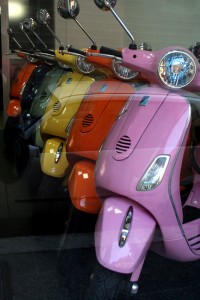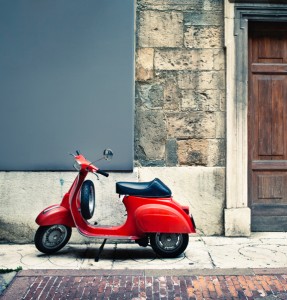In 1945 a very important “baby” was born to two very proud parents, mother Italy and father Enrico Piaggio. Her name was Vespa and she weighed in at about 75 kilos. While other types of scooters had already been in use for some time around the world (from roughly 1914 and even a bit earlier), Piaggio’s Vespa became -and remains- the standard for scooter design today.
Conception to Birth: Post World War II Italian industries found themselves struggling to recuperate and move forward. A lot of industries had converted their manufacturing efforts into productions for the war (such as  aircraft, as in the Piaggio family’s case), many of them found themselves quite literally in rubble after the Allied bombings at the end of the war. Enrico, being the second generation owner of his family’s company, knew he had to shift gears in what they would be producing in a now very different Italy (and world). He opted to design a scooter that would be cheap and reliable. The very first design got the nickname “Paperino” (Italian name for Donald Duck) but Enrico didn’t like the design. With the help of aircraft engineer Corradino D’Ascanio, the first approved model of the scooter was born and this was quickly named the “Vespa”. The name came from the original design’s look and high-pitched engine sound, as the word “vespa” means “wasp”!
aircraft, as in the Piaggio family’s case), many of them found themselves quite literally in rubble after the Allied bombings at the end of the war. Enrico, being the second generation owner of his family’s company, knew he had to shift gears in what they would be producing in a now very different Italy (and world). He opted to design a scooter that would be cheap and reliable. The very first design got the nickname “Paperino” (Italian name for Donald Duck) but Enrico didn’t like the design. With the help of aircraft engineer Corradino D’Ascanio, the first approved model of the scooter was born and this was quickly named the “Vespa”. The name came from the original design’s look and high-pitched engine sound, as the word “vespa” means “wasp”!
The Early Years: The first few years were not extremely promising but by 1950 sales shot up and foreign companies began taking license to manufacture the now famous Vespa abroad. One of these important early foreign interests was by a British motorcycle company. The popularity of the Italian Vespa in the UK certainly is at least partially to blame for its subsequent worldwide notoriety.
The Mod Years: 1960’s Mod culture in Britain heavily embraced the Vespa (and its main competitor the Lambretta) making it not solely a cheap and easy way to get around the city, but also a fashion statement. In fact it’s said that Mod’s didn’t merely accessorize their Vespas…they “over-accessorized” them, adding on loads of extra mirrors, luggage racks, fog lights, name plates, etc.
Competition: Shortly after the Vespa’s debut, in 1947 another Italian company released a very similar product, the Lambretta. The Lambretta’s birth is practically identical to that of the Vespa, with the owner Ferdinando Innocenti struggling to make a new product after the second World War left his Milan-based company limping. Initially Innocenti rejected the design made by the very same aeronautics engineer D’Ascanio, who then went on to make the prototype of the famed Vespa. Both became iconic scooters in the 50’s and 60’s, but the Lambretta company began to struggle in the 70’s, and was bought by foreign investors.
In Popular Culture: The Vespa has made many famous appearances: On the iconic cover of the early 70’s album Quadrophenia by The Who (directly related to the ultimate in hip accessory it had become in the concurrent British Mod subculture), with Audrey Hepburn and Gregory Peck sharing a ride and zooming around Rome in the film Roman Holiday, in the possession of celebrities like Marlon Brando, Charlton Heston, John Wayne, and Dean Martin, and in more modern days has experienced a resurgence globally but especially in America as a vintage and stylish way to get around. This Vintage hit has quite a modern appeal…both for scooter aficionado’s and collectors as well as people that just love the look of the logo or image on shirts, bags, calendars, mugs, and any other type of souvenir or knick knack you might think of. It’s an unmistakable modern day Italian icon.
Modern Use: Since the initial model was spawned, there have been 138 different models made. Currently there are just 4 of these models manufactured. Though the main design remains largely unchanged, there have been a lot of alterations between model types in frame size, speed, transmission (ie: an automatic transmission was eventually introduced in some models), power efficiency and even in wheel numbers. The Vespa has recently grown in popularity in the North American markets after some adjustments in engine power and the production of high-end “touring” Vespas which make it apt for long-distance driving. In Europe and Italy alike, they still prove to be popular due to cost and efficiency…and consider how much easier they are in terms of traffic and parking in congested cities compared to cars! Despite changes in ownership, manufacturing, and even bankruptcy, the Vespa resists and lives on.
A Sharp Future: Vespa, despite any changes in trends through the decades and despite economic woes does not appear to be zipping out of sight any time soon. 2011 saw the unveiling of the newest model, the “Quarantasei” (Forty-six), a throwback to the very first model in 1945 with all the modern goods (ie: much better engine and modern fuel injection system). We can expect to see the same sleek looks that made the scooter famous as well as the same low cost effects (air-cooling system rather than costly radiator systems, for example). And we can even expect to see more work in the hybrid versions.
Feeling Brave? You can even complete your own Roman holiday by renting a Vespa and taking a ride around town! This is of course not something I’d recommend for inexperienced scooter-drivers…Roman traffic is not for the scooter-shy! We at LivItaly, offer the opportunity to see Rome on a Vespa, with one of our professional guides. Check out our Vespa Tours.

